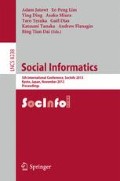Abstract
One classic problem definition in social network analysis is the study of diffusion in networks, which enables us to tackle problems like favoring the adoption of positive technologies. Most of the attention has been turned to how to maximize the number of influenced nodes, but this approach misses the fact that different scenarios imply different diffusion dynamics, only slightly related to maximizing the number of nodes involved. In this paper we measure three different dimensions of social prominence: the Width, i.e. the ratio of neighbors influenced by a node; the Depth, i.e. the degrees of separation from a node to the nodes perceiving its prominence; and the Strength, i.e. the intensity of the prominence of a node. By defining a procedure to extract prominent users in complex networks, we detect associations between the three dimensions of social prominence and classical network statistics. We validate our results on a social network extracted from the Last.Fm music platform.
Access this chapter
Tax calculation will be finalised at checkout
Purchases are for personal use only
Preview
Unable to display preview. Download preview PDF.
References
Berlingerio, M., Coscia, M., Giannotti, F.: Mining the temporal dimension of the information propagation. In: Adams, N.M., Robardet, C., Siebes, A., Boulicaut, J.-F. (eds.) IDA 2009. LNCS, vol. 5772, pp. 237–248. Springer, Heidelberg (2009)
Burt, R.S.: Social contagion and innovation: Cohesion versus structural equivalence. American Journal of Sociology 92(6), 1287–1335 (1987)
Cha, M., Haddadi, H., Benevenuto, F., Gummadi, K.P.: Measuring user influence in twitter: The million follower fallacy. In: ICWSM (2010)
Christakis, N.A., Fowler, J.H.: The spread of obesity in a large social network over 32 years. New England Journal of Medicine 357(4), 370–379 (2007)
Christakis, N.A., Fowler, J.H.: The collective dynamics of smoking in a large social network. New England Jou. of Medicine 358(21), 2249–2258 (2008)
Colizza, V., Barrat, A., Barthelemy, M., Valleron, A.-J., Vespignani, A.: Modeling the worldwide spread of pandemic influenza: Baseline case and containment interventions. PLoS Medicine 4(1), e13 (2007)
Cordella, L.P., Foggia, P., Sansone, C., Vento, M.: A (sub)graph isomorphism algorithm for matching large graphs. IEEE Transactions on Pattern Analysis and Machine Intelligence 26(10), 1367–1372 (2004)
Coscia, M.: Competition and success in the meme pool: a case study on quickmeme.com. In: ICWSM (2013)
Fowler, J.H., Christakis, N.A.: Dynamic spread of happiness in a large social network: longitudinal analysis over 20 years in the framingham heart study. Bmj Clinical Research Ed. 337(2), a2338–a2338 (2008)
Goyal, A., Bonchi, F., Lakshmanan, L.V.S.: Discovering leaders from community actions. In: CIKM, pp. 499–508 (2008)
Kermack, W.O., McKendrick, A.G.: A contribution to the mathematical theory of epidemics. The Royal Society of London Series A 115(772), 700–721 (1927)
Kiang, M.Y., Kumar, A.: A comparative analysis of an extended som network and k-means analysis. Int. J. Know.-Based Intell. Eng. Syst. 8(1), 9–15 (2004)
Kohonen, T.: The self-organizing map. IEEE 78, 1464–1480 (1990)
Kumar, U.A., Dhamija, Y.: A comparative analysis of som neural network with k-means clustering algorithm. In: Proceedings of IEEE International Conference on Management of Innovation and Technology, pp. 55–59 (2004)
Liu, Y.-Y., Slotine, J.-J., Barabasi, A.-L.: Controllability of complex networks. Nature 473(7346), 167–173 (2011)
Pastor-Satorras, R., Vespignani, A.: Epidemic spreading in scale-free networks. Physical Review Letters 86(14), 3200–3203 (2001)
Wang, P., González, M.C., Hidalgo, C.A., Barabási, A.-L.: Understanding the spreading patterns of mobile phone viruses. Science 324(5930), 1071–1076 (2009)
Author information
Authors and Affiliations
Editor information
Editors and Affiliations
Rights and permissions
Copyright information
© 2013 Springer International Publishing Switzerland
About this paper
Cite this paper
Pennacchioli, D., Rossetti, G., Pappalardo, L., Pedreschi, D., Giannotti, F., Coscia, M. (2013). The Three Dimensions of Social Prominence. In: Jatowt, A., et al. Social Informatics. SocInfo 2013. Lecture Notes in Computer Science, vol 8238. Springer, Cham. https://doi.org/10.1007/978-3-319-03260-3_28
Download citation
DOI: https://doi.org/10.1007/978-3-319-03260-3_28
Publisher Name: Springer, Cham
Print ISBN: 978-3-319-03259-7
Online ISBN: 978-3-319-03260-3
eBook Packages: Computer ScienceComputer Science (R0)

